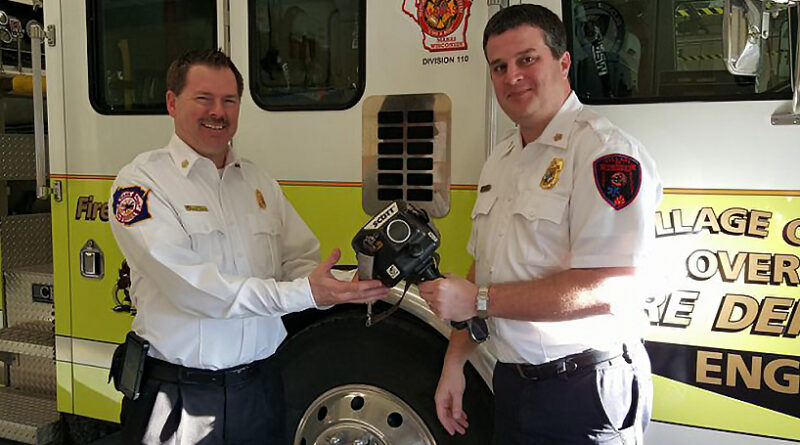Plover, Dewey FDs to host new firefighting drone program
By Brandi Makuski
Two local fire chiefs have been tapped to participate in the pilot program of a FEMA-funded project that introduces a new type of drone into firefighters’ arsenal.
Plover Fire Chief Mark Deaver and Dewey Fire Chief Brian Lepper say they’ve spent some of their downtimes over the past 18 months jointly researching what it might take to bring a firefighting drone to Portage County.
Like most local fire chiefs, the two are friends but struck up a sort of kinship after being chosen in 2018 to participate in the 13th season of Dancing With the Stars. Both were eliminated in the first round.
“We had that in common, it was something silly to kind of bond over and joke about,” Deaver said. “So when Chief Lepper brought up the idea of looking into a water-carrying drone for our two departments, I was excited to work with him on it.”
While both departments have mutual aid agreements with others, Deaver’s department primarily covers the village and town of Plover, while Lepper’s department covers Dewey and other areas in the northern part of Portage Co. With the exception of the village interior, both areas are rural — meaning less access to hydrants and other water sources.
Lepper said there was no real intention of applying for the drone program, but he suspects that requests made by him and Deaver for various bits of information put them on FEMA’s radar.
“I was really shocked when I got the call, but apparently, FEMA wants to use smaller departments like Dewey and Plover to test this program on,” Lepper said. “Even though it’s temporary, it’ll help with the staffing shortages currently being experienced in Fire/EMS. And FEMA is usually reactive, so when they’re proactive like this, I just at that chance.”
Firefighting drones have existed for a number of years, outfitted with cameras and sensors to detect the exact location and size of wildland fires. The information is displayed on a computer screen so fire chiefs can determine the best assets to deploy — and more quickly than a visual inspection from the ground.
But the pilot program, Lepper said, would bring a new type of Water-Carrying Device (WCD) drone for the two departments to test, and for deployment anywhere in the county. The WCD has a two-hour flight time with a range of 80 miles.
The Aerial ScooperDrone, the firefighting robot that’s been in testing phases since 2008 by Drone America, operates autonomously with a human monitoring the flight. It can be outfitted with self-inflating life rafts for quick water rescues; cargo netting to drop emergency supplies in an isolated area; and, more importantly, Lepper said, a collapsible tank, made of tarp-like material, that can carry up to 1,000 gallons of water to a rural fire.
“It’s way more than we’ll ever need, but when you think of the time and resources spent on the logistics of running water back and forth on a country road, and the cops or deputies you need to close those routes off to public traffic, and needing additional water trucks…with the drone, we can think about where those people could be put to better use on a fire scene,” Lepper said. “So even though this is just a temporary pilot program, we’re going to take full advantage.”
Deaver added that having a drone “on staff” would also help reduce firefighters’ exposure to smoke and cancer-causing carcinogens that’s a source of constant concern in the fire industry.
If the pilot program is a success, Deaver and Lepper say they’d may consider applying for a grant to keep the program here permanently.
“We’d either need the world’s biggest bake sale or one heck of a grant because we’re looking at at least a $500,000 expense, and that’s not including any customization we’d need,” Deaver said. “But it’s one way we could help address the volunteer firefighter shortage in the long-term.”
The new drone is expected to arrive sometime in June for a 24-month testing program.


